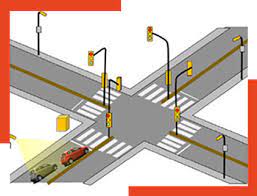Traffic Control: Ensuring Smooth and Safe Roadways
In today’s fast-paced world, traffic control plays a crucial role in maintaining order and safety on our roadways. Whether it’s a bustling city intersection or a busy highway, effective traffic control measures are essential to keep vehicles moving smoothly and to prevent accidents.
One of the primary objectives of traffic control is to regulate the flow of vehicles. This involves implementing various strategies such as traffic signals, signage, lane markings, and speed limits. Traffic signals, commonly known as traffic lights, are strategically placed at intersections to guide drivers and pedestrians by providing clear instructions on when to stop, go, or yield. These signals help prevent collisions and ensure that all road users can move through the intersection safely.
Another critical aspect of traffic control is the use of signage. Road signs provide valuable information to drivers regarding speed limits, directions, upcoming hazards or obstacles, parking zones, and more. By following these signs, motorists can navigate their way efficiently while ensuring their safety and the safety of others.
Lane markings are also an integral part of traffic control. They delineate separate lanes for different types of vehicles and indicate where drivers should position themselves on the road. Lane markings help maintain order by preventing unnecessary lane changes or encroachments into other lanes. They also assist in guiding drivers through complex intersections or highway interchanges.
Speed limits are enforced as part of traffic control measures to ensure that vehicles travel at safe speeds appropriate for specific road conditions. Speeding not only increases the risk of accidents but also reduces a driver’s ability to react in time to unexpected situations. By adhering to posted speed limits, drivers contribute significantly to maintaining overall road safety.
Traffic control also extends beyond physical infrastructure; it includes the presence of trained personnel such as police officers or flaggers who manage traffic during construction zones or special events. These individuals direct vehicles using hand signals or flags and ensure that all motorists follow temporary detours or lane closures, keeping traffic flowing smoothly and safely.
Additionally, advancements in technology have revolutionized traffic control systems. Intelligent Transportation Systems (ITS) leverage sensors, cameras, and real-time data to monitor traffic conditions and adjust signal timings accordingly. This helps optimize traffic flow, reduce congestion, and enhance overall efficiency on the roadways.
Efficient traffic control not only benefits motorists but also pedestrians and cyclists. Well-designed crosswalks, pedestrian signals, and dedicated cycling lanes ensure their safety and encourage active modes of transportation. By creating a safe environment for all road users, traffic control fosters a sense of community and promotes sustainable transportation options.
In conclusion, traffic control plays a vital role in ensuring smooth and safe roadways. Through the implementation of various measures such as traffic signals, signage, lane markings, speed limits, and the presence of trained personnel or advanced technology systems, we can effectively manage traffic flow and minimize potential hazards. By adhering to these controls and being mindful of our responsibilities as drivers or pedestrians, we contribute to a safer and more efficient transportation system for everyone.
Frequently Asked Questions About Traffic Control: Explained
- How many types of traffic control are there?
- What do you mean by traffic control?
- Why control the traffic?
- What are the basics of traffic control?
How many types of traffic control are there?
There are several types of traffic control measures used to regulate and manage traffic flow. Here are some common types:
- Traffic Signals: Traffic signals, also known as traffic lights, use a system of red, yellow, and green lights to control the movement of vehicles at intersections.
- Road Signs: Road signs provide important information to drivers, such as speed limits, directions, warnings about upcoming hazards or obstacles, parking zones, and more.
- Lane Markings: Lane markings on the road help guide drivers by indicating separate lanes for different types of vehicles and guiding them through intersections or highway interchanges.
- Speed Limits: Speed limits are enforced to ensure that vehicles travel at safe speeds appropriate for specific road conditions. They help prevent accidents and maintain overall road safety.
- Traffic Calming Measures: These measures are designed to slow down vehicle speeds in residential areas or areas with high pedestrian activity. Examples include speed humps, roundabouts, or narrowing roadways.
- Traffic Control Personnel: Trained personnel such as police officers or flaggers manage traffic during construction zones or special events. They direct vehicles using hand signals or flags and ensure compliance with temporary detours or lane closures.
- Intelligent Transportation Systems (ITS): ITS utilizes technology such as sensors, cameras, and real-time data to monitor traffic conditions and adjust signal timings accordingly. This helps optimize traffic flow and reduce congestion.
- Pedestrian Crosswalks and Signals: Crosswalks with designated pedestrian signals allow pedestrians to safely cross roads by controlling vehicle movements at specific intervals.
- Cycling Infrastructure: Dedicated cycling lanes or paths provide safe spaces for cyclists while separating them from vehicular traffic.
- Temporary Traffic Control Devices: These devices include cones, barricades, signs, and temporary markings used during construction projects or road maintenance activities to guide drivers safely through work zones.
These various types of traffic control measures work together to ensure smooth traffic flow, enhance road safety, and create a more efficient transportation system.
What do you mean by traffic control?
Traffic control refers to the systematic management and regulation of vehicular and pedestrian movement on roads, highways, and intersections. It involves implementing various measures and strategies to ensure the safe and efficient flow of traffic while minimizing congestion and reducing the risk of accidents.
Traffic control encompasses a range of elements, including traffic signals (traffic lights), signage, lane markings, speed limits, road design, enforcement by law enforcement personnel, and advanced technologies such as Intelligent Transportation Systems (ITS). These measures work together to guide drivers, cyclists, and pedestrians through roadways in an organized manner.
The primary objectives of traffic control are:
- Regulating Traffic Flow: Traffic control aims to maintain orderly movement by controlling the interaction between vehicles at intersections or on highways. This is achieved through the use of traffic signals that indicate when to stop, go, or yield. It also involves managing lane configurations and providing clear instructions through signage.
- Ensuring Safety: Safety is a paramount concern in traffic control. Measures such as speed limits help prevent accidents by ensuring that vehicles travel at appropriate speeds for specific road conditions. Road signs provide essential information about hazards, parking zones, directions, and other relevant details to help drivers navigate safely.
- Minimizing Congestion: Traffic control strategies are employed to manage congestion during peak hours or in areas with high vehicle volumes. This includes optimizing signal timings based on real-time traffic data or implementing alternative routes during construction or special events.
- Protecting Vulnerable Road Users: Traffic control considers the safety of pedestrians and cyclists by providing designated crosswalks, pedestrian signals, cycling lanes, and other infrastructure that separates them from vehicular traffic. These measures encourage active transportation modes while ensuring their safety.
- Enhancing Efficiency: Advanced technologies like ITS play a crucial role in modern traffic control systems. They use sensors, cameras, and real-time data analysis to monitor traffic conditions and adjust signal timings accordingly. This helps optimize traffic flow, reduce delays, and improve overall transportation efficiency.
Overall, traffic control aims to create a safe, orderly, and efficient transportation system for all road users. By implementing effective measures and adhering to traffic regulations, we can minimize accidents, reduce congestion, and promote smoother travel experiences.
Why control the traffic?
Controlling traffic is essential for several reasons:
- Safety: The primary objective of traffic control is to ensure the safety of all road users. By regulating the flow of vehicles, implementing speed limits, and providing clear signage and signals, traffic control measures help prevent accidents and reduce the risk of injuries or fatalities.
- Orderly Movement: Traffic control helps maintain orderly movement on the roadways. By guiding drivers through intersections, indicating proper lanes, and managing traffic during peak hours or special events, it prevents congestion and ensures a smooth flow of vehicles.
- Efficiency: Efficient traffic control measures contribute to improved traffic flow and reduced travel times. By optimizing signal timings, implementing intelligent transportation systems, and managing lane assignments effectively, traffic congestion can be minimized, enhancing overall transportation efficiency.
- Environmental Impact: Congested traffic leads to increased fuel consumption and emissions, contributing to air pollution and environmental degradation. By implementing effective traffic control measures that reduce congestion and promote smoother traffic flow, we can help mitigate these environmental impacts.
- Emergency Response: During emergencies or disasters, effective traffic control becomes even more critical. By providing clear routes for emergency vehicles and managing traffic diversions when necessary, authorities can ensure that emergency responders can reach their destinations quickly and efficiently.
- Pedestrian Safety: Traffic control also focuses on ensuring the safety of pedestrians by providing designated crosswalks, pedestrian signals, and appropriate signage. This encourages walking as a mode of transportation while safeguarding pedestrians from potential accidents.
- Compliance with Laws: Traffic control measures enforce compliance with laws and regulations related to road safety. This includes adhering to speed limits, following lane markings, obeying traffic signals, and respecting right-of-way rules. Such compliance contributes to a safer road environment for everyone.
Overall, controlling traffic is crucial for maintaining safety on the roads, promoting efficient transportation systems, reducing congestion and environmental impact while ensuring compliance with laws and regulations. It plays a vital role in creating a harmonious and sustainable transportation network for the benefit of all road users.
What are the basics of traffic control?
The basics of traffic control involve several key elements that work together to regulate and manage the flow of vehicles on roadways. These elements include:
- Traffic Signals: Traffic signals, commonly known as traffic lights, are installed at intersections to control the movement of vehicles and pedestrians. They use a system of red, yellow, and green lights to indicate when drivers should stop, proceed with caution, or go.
- Signage: Road signs provide important information to drivers, such as speed limits, directions, warnings about upcoming hazards or obstacles, parking regulations, and more. Signs are strategically placed along roadways to guide drivers and ensure they are aware of relevant information.
- Lane Markings: Lane markings are painted lines on the road that separate different lanes of traffic. They help drivers stay in their designated lanes and navigate through intersections or highway interchanges safely. Lane markings also indicate where passing is allowed or prohibited.
- Speed Limits: Speed limits are set for different types of roads based on factors such as road conditions, surrounding environment, and safety considerations. Speed limits inform drivers about the maximum safe speed at which they should travel on a particular road.
- Traffic Control Devices: These include devices such as cones, barricades, and barriers that are used during construction or maintenance activities to redirect traffic or create temporary lane closures. These devices ensure the safety of both motorists and workers in work zones.
- Trained Personnel: In certain situations like construction zones or special events, trained personnel such as police officers or flaggers may be present to manage traffic flow manually using hand signals or flags. Their role is to direct vehicles through temporary detours or lane closures effectively.
- Intelligent Transportation Systems (ITS): ITS uses advanced technologies like sensors, cameras, and real-time data analysis to monitor traffic conditions and optimize signal timings accordingly. This helps improve traffic flow efficiency by reducing congestion and minimizing delays.
By combining these basic elements, traffic control aims to maintain order, safety, and efficiency on roadways. It ensures that vehicles can move smoothly, reduces the risk of accidents, and enhances overall transportation experience for all road users.


